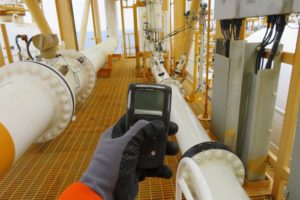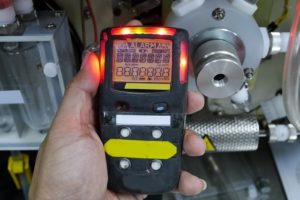An effective gas leakage detection system is both complicated and really simple at the same time. Properly calibrated and used, gas leakage detection equipment is simple to read and can pick up on the minutest presence of poisonous or dangerous gases, which can save your life and the lives of your co-workers or employees. What goes into that fairly simple reading, however, is pretty sophisticated and complicated. Here is a summary to help you understand how gas leakage detection works and why it’s so important.

Gas Leak Detection Equipment Can Be Confusing
For the most part, gas leak detection monitors are highly sensitive and accurate. Occasionally, however, even the best equipment can get fooled. For example, a monitor can, under the right circumstance, give a false positive. It can misread gas content or even get confused. This is why rigorous maintenance, testing, and calibrating is paramount to ensuring your gas detection equipment works correctly.
The Breathing Zone
As defined by OSHA, a breathing zone is a 10-inch radius around a worker’s nose and mouth. By setting a gas-detection monitor in that zone, the chances of getting an immediate warning when gas could harm an employee is possible. Some people argue that, because some gases are heavier, the detector should be lower on the body. However, positioning it there can result in the equipment being damaged or lost as well as not being able to detect poisonous gas in the breathing area of an employee.
Pump or No Pump
Gas detectors come in two forms: Passive, which uses ambient airflow to monitor for gas, and active, which utilizes pump technology to bring air into the detector for analysis. While the type of gas leak detection equipment that you use is a personal preference, there are many who prefer one over the other or choose depending on the environment they are working in. Regardless, the detector sensors only work sampling the air in the immediate vicinity. The best application of a detector with a pump is when the air has to be sampled remotely; sending a detector with a pump into an enclosed space will guarantee that the air in that space is sampled, while a more passive system may not adequately test the air in the workspace.
Bump Test or Not to Bump Test'
A bump test is when the gas detector is exposed to gas to ensure the sensors are working correctly. All this test does, however, is verify that the sensors work when the gas concentration in the air reaches that level or slightly below it. It doesn’t test accuracy or if calibration is needed.
For that type of testing, a calibration test is needed. This is performed by exposing the monitor to a concentrated quantity of gas for a set time. If the sensors are accurate, they will display the same data—or very close to it—as the concentration of the gas. The accuracy of a reading generally depends on how the detector is used.
Gas AlarmFor most users, merely being told a potentially hazardous gas is present in a workspace is enough. In some industries, however, knowing the concentration in the air is important. In the vast majority of cases, just being warned is sufficient.

Gas leakage detection equipment can be a lifesaver. Understanding how it works and how to use it, though, is key to it being used in the most optimum manner possible. For more information on gas detectors and how they work, check out DOD Technologies, Inc.






